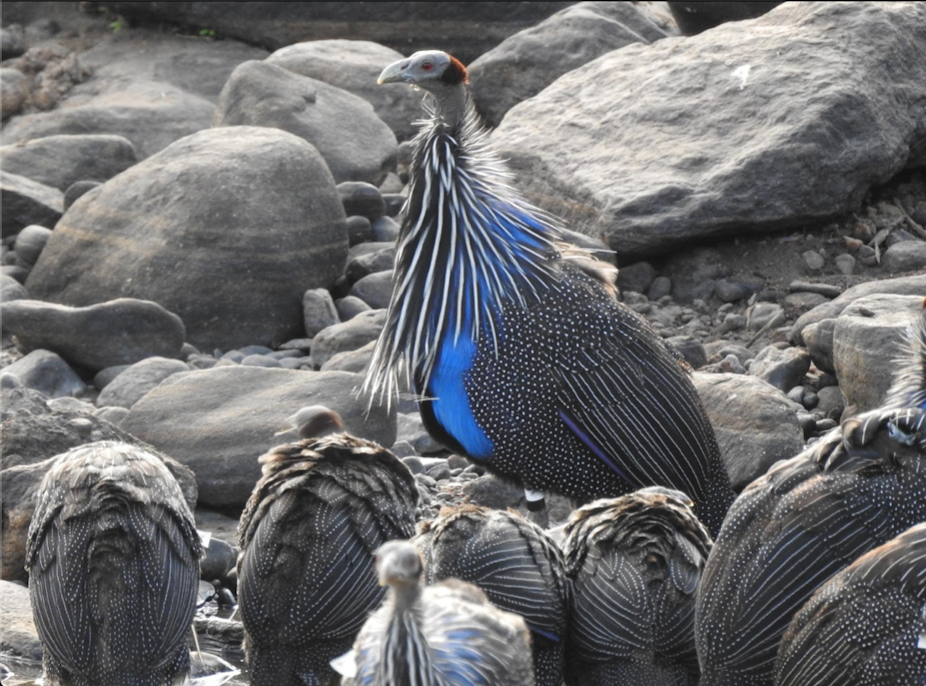Multilevel societies – ones in which strong and consistent bonds are established within and between groups – have only been known to exist among large-brained mammals including humans, other primates, elephants, giraffes and dolphins.
But a group of scientists, of which we are part, recently published research that shows the existence of a multilevel society in a small-brained bird: the vulturine guineafowl (Acryllium vulturinum). These guineafowl are common in savannah-woodland ecosystems of central-east Africa.
A multilevel society requires animals to keep track of individuals in both their own and other groups. The assumption has therefore been they should only exist in species with the intelligence to cope with this complexity.
While many bird species live in groups, these tend not to operate in a layered way. They tend to be open (birds come and go) and lack long-term stability, or they are highly territorial. Mostly, they lack associations with other groups.
Vulturine guineafowl present a striking exception. Our study – the first ever conducted on the species – suggests that the birds can keep track of who is in their own group as well as who is in other groups.
We found that vulturine guineafowl live in large, sexually mixed groups, and membership in these groups is stable over years. These groups choose to associate with other specific groups. Another finding is that the guineafowl rarely show intergroup aggression – a common feature in most other group-living birds, such as pied babblers. This is because living in groups has long been associated with maintaining and defending a territory.
Our findings challenge the notion that large brains are needed for complex societies. To our knowledge, this is the first time that such a social structure has been described in birds.
Tracking relationships
For three years the study tracked the membership of two guineafowl groups. It also tracked a population of over 400 birds for a year. All of this was done at the Mpala Research Centre in central Kenya. Our team, which involved Kenyan students, and was conducted in collaboration with the National Museums of Kenya and permitted by the Kenyan Wildlife Service, individually marked all the birds in this population.
From our early observations, we noticed that the vulturine guineafowls comprised multiple social groups. We also noticed that groups regularly encountered other groups, moving together during the day and roosting at night.
Getting evidence that what we observed was in fact a multilevel society required a substantial field effort. The team conducted daily census observations of marked birds, recording who was spending each day with whom.
Our data confirmed that groups remained completely stable, and revealed that our population contained 18 distinct social groups. These comprised between 13 and 65 individual members. When groups encountered or roosted with other groups, we could show that they always split back up into their original group membership.
Our data also showed that groups regularly encountered and associated with other groups, both during the day and at communal roosts. But we also wanted to see how groups moved in relation to each other, and whether there was some higher-level structure of between-group associations. We did this by attaching a GPS tag to between one and five individuals from each group. These tags allowed us to simultaneously record where each group was for every moment of every day.
The GPS data allowed us to dig much deeper into the patterns of between-group associations. Amazingly, we found that up to eight distinct groups could roost together on a given night. In the morning, once the birds left the roost, they reformed into their regular groups and moved off for the day.
The socialising didn’t end at the roost. We found groups regularly encountered each other during the day, and these encounters appear to be preferential, with groups seeming to have social preferences for certain other groups.
The GPS data revealed a clue about why intergroup associations take place. We found that seasons played a role on where intergroup associations were likely to happen: close to the river in the dry season and on the resource-rich open grassy glades during the wetter seasons. These data suggest that intergroup associations might be a protection mechanism – by forming supergroups – in areas where they are prone to being predated.
Despite being understudied, the vulturine guineafowl is challenging our current understanding of social behaviour. Our discovery raises a lot of questions about the mechanisms underlying complex societies. It has opened up exciting possibilities of exploring what it is about this bird that has made them evolve a social system that’s more like that of a primate than other birds.
We hope that vulturine guineafowl will hold more clues about how complex societies might have evolved. Further, we hope that our study will inspire others to search for complex societies in places where they might not previously have expected to find them.

